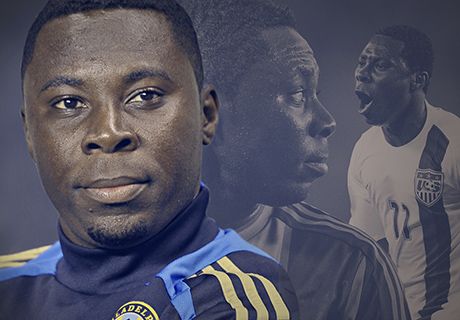There is always a success story behind every distinguished player. Many soccer stars started out as promising young talents and went on to win individual awards, trophies and above all, fame. On the other hand, there have been countless youth prospects who either never made it or their careers were not worthy of their potential. In their case, their…success stories were left incomplete. Almost unwritten.
According to a recent FIFA study, only up to 2% of active soccer players worldwide are professionals with their lives financially depending on the game. The rest of them play at amateur level or just for fun and social reasons. This tiny percentage resembles that of the distribution of wealth among individuals on the planet. Shocking?
Talented young players destined for success or greatness but faded away or blew it, have existed throughout the world soccer history. And inevitably they will. The reasons? Along with the skills comes pressure, sometimes intolerable and too hard to handle at a young age. Injuries, psychological issues, lack of fitness or motivation, poor management from coaches, overestimation of abilities, the adolescence and its challenges or just bad luck have also undone many young talents.
To pick a handful of them as the best…lost talents ever is not easy. But this research focuses on those who stood out as teenage players even drawing comparisons to all time greats and then dissappeared by the beginning of adulthood, at 18. An age that should be considered as the threshold for a teenager to be considered a talent.
Thus, players like Adriano, Portillo, Mutu, Quaresma, Bojan, Harald Nielsen, Denilson, Cassano, Caio, Adailton were excluded as they could be more precisely described as ”wasted talents”. They enjoyed relatively successful or average top flight careers as professionals. Just not at the level many expected or envisioned. And it was again their youth potential that set the bar astronomically high.
The cristeria for the research -apart from skills- were:
- Performances and unprecedented world or national records in teenage years
- Lack of progress as adult players or lower-league soccer
- Attention they drew from press and media
- Early retirement due to unforeseeable circumstances
Below are 6 players who despite their natural ability they surprisingly underperformed once they turned pros or their promising careers were cut short by unexpected circumstances. The order is alphabetical.
#1. Adu (USA)
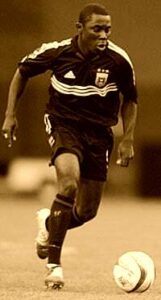
Name: Freddy Adu
Date and country of birth: 2 June 1989, Ghana
Jersey numbers: #7, #9, #11, #15, #19, #20, #21, #30
Position: Attacking midfielder, Forward
Records: Youngest ever MLS scorer at 14 years and 75 days. Only player to feature in 4 youth World Cups (2003 x2, 2005, 2007)
He was touted as the ”next Pele” since he was 12. Two years later he became the youngest athlete ever to sign a professional contract in the United States. He has been without a doubt the most talked-about youth in the American soccer history.
Freddy Adu was born and raised in Tema, Ghana, where he learned soccer through informal pick-up games. He lived in Ghana until 1997, aged 8. In November 1997, Adu moved to the U.S. after his mother won a green card through the Diversity Immigrant Visa lottery program. His family settled down in Potomac, Maryland, and he was discovered by Arnold Tarzy, a young coach who had not played competitive soccer beyond junior high school, but he would become Adu’s mentor. It all started after a neighbourhood league game in 1998. Tarzy was amazed by 8-year-old Adu’s skills and invited him to practice with the junior team he was coaching, the Potomac Cougars.
Adu was soon indoctrinated into the Olympic Development Program and began competing against older players in elite U.S. Soccer Federation camps. At the age of 10, Adu had already made a name as a phenom playing for the Cougars and also The Heights, his elementary school. In October 1999, the U.S. Soccer Federation staged a loosely organised youth game on the practice field at American University in Washington. Adu received an invitation and impressed during the match scoring 2 goals.
In 2000, he played in a tournament in Italy with a U.S. regional select team that competed against youth teams of Italian professional clubs, such as Inter, Lazio, Juventus and AC Milan. Despite being a few years younger than the other players, he was the tournament’s top scorer and also won the most valuable player award. His performances triggered Inter Milan’s interest followed by a lucrative offer of $125,000 in a development package that would see him move to Milan at the age of 18. The offer was rejected by his mother, Emelia.
In the 2000-01 season, 12-year-old Adu captained the Potomac Cougars and helped them win the regional title. The Cougars with Olatomiwa Ogunsola in defence and Freddy Adu with Arif Sisman up front, advanced to the U-14 national championship held in Indiana in June 2001. Adu once again guided his team to the final and the trophy. The next season he netted 25 in 16 games for his school team as a captain. At such a young age Adu was one of the fastest players, with the best head and foot skills, able to beat a handful of defenders in one run, dropping them to the ground with twists and stops. He had every single attribute of a wonderkid.
In February 2002, Adu moved from Potomac to the U.S. under-17 residency program at the IMG Academies in Bradenton, Florinda, training with players 2-3 years older than him. His Potomac Cougars teammate, defender Olatomiwa Ogunsola had also been called up by coach John Ellinger, while 15-year-old Michael Bradley was already a member of the academy. On February 12, 2003, 13-year-old Adu scored twice for the U-17 in a 2-1 exhibition victory over the first team of Chicago Fire! At the end of the 2002-03 season he was voted the Parade Player of the Year and was also the youngest ever High School All-American in any sport in the United States.
On August 14, 2003, Adu became the youngest player to feature and score in the FIFA U-17 World Cup, at 14 years and 72 days. He did not net just once, but three times, completing his hat-trick with a penalty in the stoppage time. Adu finished the tournament as a joint fourth scorer, helping his team reach the quarterfinals where the U.S. suffered a 3-0 defeat by Brazil. As about other young stars he played against? Spain’s 16 year-olds Cesk Fabregas, Javi García and David Silva in the group stage, while Fernando Gago, Ezequiel Garay, Oscar Ustari, Neri Cardozo (Argentina), Joao Moutinho, Manuel Fernandes, Vieirinha (Portugal), Fredy Guarin (Colombia), Keylor Navas (Costa Rica), Mikel John Obi (Nigeria), Alex Song (Cameroon), and Tim Sparv (Finland) also played in the 2003 edition.
On December 2, 2003, he set another incredible record by participating in the FIFA U-20 World Cup, at just 14 years and 180 days! He came on as a sub in the 3-1 defeat by Germany. Adu was part of a USA squad that also included Clint Dempsey and Eddie Johnson. Who else was playing in the tournament? Carlos Tevez, Javier Mascherano, Fernandinho, Nelson Valdez, Dani Alves and Andres Iniesta!
Adu played for the United States in other two international youth tournaments: the 2005 and 2007 FIFA U-20 World Cups. The latter was hosted by Canada and Freddy, 18, a D.C. United player at the time, participated as the captain of his side despite being one of its youngest members. He had already been signed by the ”Black-and-Red” in a 6-year deal in November 2003, becoming the youngest American athlete ever to sign a major league professional contract. He was only 14 years and 168 days and MLS’ highest paid player.
On April 3, 2004 he debuted for D.C. United in MLS, two months before his 15th birthday, breaking Santino Quaranta‘s 2001 record. Two weeks later he would score his first league goal in United’s 3-2 loss to the NY Metrostars, the youngest to do so in MLS history, at 14 years and 75 days. He finished his first season with 5 goals in 30 appearances in a squad coached by Polish Piotr Nowak and alongside players like Bolivia international Jaime Moreno, New Zealand’s Ryan Nelsen, Ukrainian Dema Kovalenko, Ben Olsen, Ernie Stewart, Nick Rimando and Alecko Eskandarian.
Having already rejected Ghana’s call-up, Adu playing his first match for the United States on January 22, 2006, in a friendly against Canada, at 16 years and 234 days. But 10 months later on December 11, 2006, his journeyman career would start representing 10 clubs (Real Salt Lake, Philadelphia Union, Tampa Bay Rowdies, Las Vegas Lights, Benfica, Belenenses, Monaco, Aris, Rizespor, Jagodina, KuPS, KuFu 98, Bahia, Osterlen) in nine countries and including lower divisions. On top of that, he also had unsuccessful trials with Blackpool, Stabaek, AZ Alkmaar and MLS’ Portland Timbers. He scored 31 goals in 227 club appearances, with half of them recorded before he turned 18. Adu has not featured in any official game since 2018, aged 29.
A wonderkid that once had attracted interest from top clubs in the world (Manchester United, Real Madrid, Inter, AC Milan) and signed multi-million dollar deals with Nike, did not live up to the enormous expectations laid on him from the press and fans. Instead, he turned into one of the greatest disappointments in soccer history.
#2.Carrizo (Argentina)
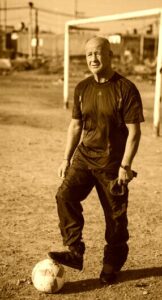
Name: Gregorio ”Goyo” Carrizo
Year and country of birth: 1960, Argentina
Jersey numbers: #9, #16
Position: Centre-forward
He has been labelled as ”el otro Maradona” (the other Maradona). The apparent comparison reflects the player’s worth and huge potential. At least during the early years of his career when Carrizo was playing with ”Diegito” in their Buenos Aires neighbourhood, the Villa Fiorito, in the late 1960s. They were the leaders of their own teams: ”Tres Banderas” versus ”Estrellas Rojas”. Gregorio ”Goyo” Carrizo was Maradona’s neighbour, schoolmate, best friend and also his biggest soccer rival!
On a Saturday in March 1969, ”Goyo” joined a trial for 9 year-old boys hosted by Cebollitas. Youth coach Francis Gregorio Cornejo picked only Carrizo out of 40 boys! He immediately registered with the junior team which was affiliated to Argentinos Juniors. Unselfish Carrizo spoke to Cornejo about his friend Maradona and convinced the young coach to give him a chance too. After Maradona unsurprisingly impressed during his trial the following week, they became club teammates.
Between 1973 and 1974 Cebollitas went undefeated for a staggering 141 matches in a row, even against teams with a higher age average. They won the “Evita” tournament in 1973 and 1974 and also played friendlies in Peru and Uruguay. The starting eleven during that lundefeated period were: Ojeda; Trotta, Chaile, Chammah, Montaña; Lucero, Dalla Buona, Maradona; Duré, Carrizo, Delgado. Other teammates of “Goyo” during the 1970s were forward Claudio Rodriguez and defenders Alberto Carabelli and Adrian Domenech. Cebollitas became the most iconic and legendary youth team in the history of Argentina’s soccer with Maradona, captain Daniel “Polvora” Delgado and Carrizo being the squad’s topscorers.
”Goyo” played and starred alongside one of the greatest players of all time for seven years until 1976, when ”Pibe d’oro” was promoted to the first team of Argentinos Juniors, aged 16. He was then followed by Adrian Domenech in 1977 and Abelardo Carabelli in 1978. The next Cebollitas player and favourite to get a call to the senior squad was Carrizo. However, the long-anticipated upgrade would not happen. The chairman’s financial offer (it was Prospero Victor Consoli at the time) was not appealing enough to make him leave his neighbourhood.
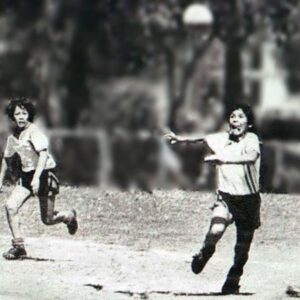
In 1980 he suffered a torn ligament during a match for the Argentinos Juniors reserves and he inevitably had to undergo an operation. Maradona was the one to help him with the medical expenses, including the rehabilitation sessions which he chose to abandon after just 20 days. Having been out of action for a year and without the necessary phychological support from club and family, Carrizo fell into depression and his decision to quit physiotherapy proved crucial for his carreer. His knee would never heal properly.
He never debuted for Argentinos Juniors, but he was an unused substitute in a league game. It was the only time he came close to play in the first division. After being released by Argentinos Juniors he joined San Telmo Sud Dock. His new club was competing in the third division of the Metropolitano Buenos Aires championship, which was also the third tier of Argentinian soccer.
Just after one season, he signed for All Boys, playing in the Buernos Aires second division alongside midfielder Rubén Galván who had previously represented almighty Independiente Avellaneda for 9 years, winning 4 Copa Libertadores. His spell with All Boys was short and Independiente Rivadavia de Mendoza was his next and final career destination. Despite the fact that he enjoyed some success with Independiente Rivadavia, his severe knee pain forced him to retire in his early 20s.
Carizzo was regarded as an all-out centre-forward with tactical intelligence, vision, with close control and strength to keep the ball. For many, he was as good as Maradona during his youth. And that says a lot about his talent.
#3.Galli (Italy)
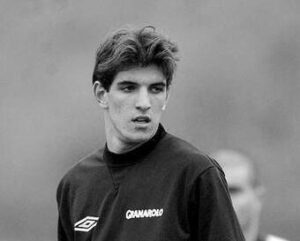 Name: Niccolò Galli
Name: Niccolò Galli
Date and country of birth: 2 May 1983, Italy
Date and country of death: 10 February 2001, Italy
Jersey numbers: #3, #4, #5, #27
Position: Centre-back
Born in a soccer family, son of Italy’s former goalkeeper Giovanni Galli, Niccolò’s only dream was to follow his father’s footsteps. 1982 World Cup winner and Diego Maradona’s teammate in Napoli in the 1990-91 season, Giovanni Galli left the ”partenopei” to sign for Torino in 1993. And Niccolò would start his soccer carreer from Toro’s junior team at the age of 10. It was the 1993-94 season and he would become good friends with his teammate Fabio Quagliarella, a future international and currently Sampdoria’s top striker.
His father’s transfer to then powerful Parma after the 1994 World Cup meant that ”parmalazzi” would be the his next youth team. In 1995 he moved to Florence -his parents’ hometown- with his mother and joined Fiorentina. His mature and outstanding performances as a centre-back showed a young player with a great talent.
He played for the youth teams of Fiorentina until 1999, aged 16. It was when his father, Giovanni, gave a phone call to Liam Brady, Arsenal’s head of youth development and academy director and a former Irish international with a lengthy carreer in Italy (Juventus, Inter, Ascoli, Sampdoria). The idea was for Niccolò to gain experience from playing abroad and become a more complete player.
He flew to London, trained with the Arsenal youth squad for a few days and it was quite apparent that he was a player of high potential, an intelligent, confident defender of 188 centimetres tall who could read the game. During his first season in England he won the Youth FA Cup with Arsenal’s U-18 team against Coventry in May 2000, playing with Steve Sidwell, Jay Bothroyd, centre-back Ben Chorley, Jermaine Pennant and other young stars. His work ethic and dedication stood out immediately, giving his 100% during the training sessions and working out extra hours afterwards. In the summer of 2000, aged 17, he was loaned to Serie A side, Bologna, but he had already caught the eye of Arsenal’s manager Arsen Wenger who had Galli in his future plans for the first team.
On October 1, he debuted as a sub in the Italian league against champions Roma at Olimpico Stadium. His opponents on the pitch? Totti, Batistuta, Montella, Cafu, Emerson and other stars coached by Fabio Capello. It was his first and only appearance for Bologna. Four months later, on February 9, 2001, Niccolò Galli’s life was cut short in a road accident on his way back from a parctice at Bologna’s training centre.
His funeral was held in Florence and was attended by people like Gabriel Batistuta -who knew young Niccolò from his time with Fiorentina- and Italy’s 1982 Word Cup winning squad because of his father. Among them was Franco Baresi, the man Niccolò Galli had been credited to succeed one day as Italy’s central defender.
Following Galli’s death, Bologna named their training centre after him and also retired his no27 shirt. The ”Niccolò Galli” youth tournament, organized by the local Soccer Association of Tuscany is being held every May in Florense to honor his memory. According to Arsene Wenger, had Niccolo lived he would have been captain of Arsenal and Italy.
#4.Pike (England)
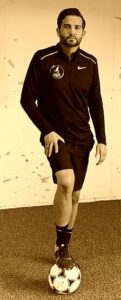
Name: Sonny Pike
Year and country of birth: 1983, England
Jersey numbers: #9, #10, #20
Position: Attacking midfielder, Forward
Record: minimum 100 goals per season, age 11-13
By the age of 12 he had been compared to all time greats like George Best and Maradona. A couple of years later he was sponsored by English brand Paul Smith, had his legs insured for £1m and was doing adverts for McDonald’s and Coca-Cola.
Nephew of the former Tottenham forward Mark Falco, Sonny Pike was born and raised in north London and at the age of 6 he joined local club Enfield Colts. In 1993 he registered with Enfield FC playing for the club’s junior team. The next two years saw Pike skyrocket to fame. He would just not stop scoring goals. Pike netted 45 in his first season with Enfield. He finished the 1994-95 season with…120 for Charlden Youth in north London. Scouts had started to notice him.
In June 1995 he was part of a regional youth selection to represent England at a “Mini World Cup” tournament in Denmark, playing alongside future stars like Ashley Young and David Bentley. The inquiries from scouts flooded in after the tournament and his father Mike started acting as his representative, before handing over to celebrity agent Eric Hall who arranged trials for the youngster. The most audacious invitation came from 1995 European champions, Ajax, with a request to move full-time to the Amsterdam.
Pike played a few matches for the club that is renowned for having the best youth academy in the world. After scoring the winner in a match against youth PSV Eindhoven he received an official offer to join the academy, but he refused opting to return to England. As he later stated his experience with Ajax was unique as he met coach Louis van Gaal and the country’s top players: Edgar Davids, Nwankwo Kanu, Marc Overmars and Patrick Kluivert. His fame had reached its peak.
Sonny Pike appeared on the pitch at the 1996 League Cup Final demonstrating keepy-ups at the behest of sponsors Coca-Cola. He was the media’s favourite teen player. After scoring 130 goals for his junior side in the 1995-96 season he decided to join the youth team of third division London club, Leyton Orient. He had previously been in touch with many Premier League clubs: Manchester United, Arsenal, Tottenham, Norwich, QPR and Ipswich. And he was only 13.
Within months into the 1996-97 season Pike went for a trial with Chelsea without his club’s permission. It was the beginning of the end. The trial was filmed, the news broke out to the media and the player was officially in breach of the regulations. The English FA banned him for a year .Pike, away from the spotlight now, started training with a local youth team under his old coach Terry Welch. But, the psychological damage for the talented teen had been already done. Trials with Crystal Palace and Queens Park Rangers followed in the next years, but without success.
He then had short spells in the youth ranks of fifth division Stevenage Borough, Barnet and Grimsby before deciding to quit soccer in 2001, at just 18. But, Pike returned to action signing again for Enfield FC. In 2003 he joined Waltham Forest of the Ryman League in the 8th English tier, playing alongside a few former professionals. He retired after a couple of seasons.
During the 1990s he was branded by the British media as a wonderkid who would be England’s next no10 or the new Paul Gasgoigne. He had even appeared on TV as a special guest on stage with Arsenal’s striker Ian Wright, being the talk of every soccer magazine and tabloid. However, that media pressure and also his father’s involvement and publicity tactics had a negative impact on him. Mike Pike had ensured that his son kept a high profile with the endorsements rolling in. They haven’t spoken since then.
According to one of his coaches, Sonny Pike had skills but lacked speed, while a former class-mate stated that he wasn’t even the best player in the school team. On the other hand, the press was comparing him to all time greats. A heavily promoted child prodigy? Possibly, but Pike was without a doubt a prolific goalscorer.
As 90% of English boys get released by pro clubs before they can sign scholarship forms at 16, Sonny Pike was one of them. In February 2020, he opened a soccer academy with an aim to transfer his knowledge and help young players.
#5.Pontikas (Greece)
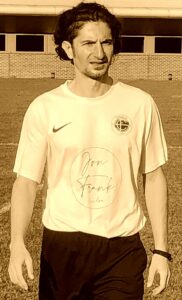
Name: Ntinos Pontikas
Date and country of birth: 27 February 1982, Greece
Jersey numbers: #8, #9, #10, #17
Position: Centre-forward
Record: Youngest hat-trick scorer in history, at 14 years and 201 days
No other young teen ever enjoyed such a spectacular first-team debut. But a bright start was doomed to fizzle out.
Ntinos Pontikas, born and raised in Greece, started playing street soccer at the age of six, just like many players of his generation. His ability to find the back of the net was evident during his neighbourhood league and school games. And it would become exposed to a wider spectrum of spectators at the age of 13. In August 1995, he was chosen to be part of a local select team, a mixture of adult and youth players, for a celebration friendly match. Despite the fact that he was the youngest on the pitch he finished the game scoring 13 goals, at 13 years and 6 months! Soon after he was recommended to the academy of a third division club. But, he instead joined the U-14 squad of Toxotis, an amateur club that had produced goalkeeper Kostas Chalkias, while future Greece international Theofanis Gekas was part of its youth team at the time. After an unsuccessful short stint with Toxotis, Pontikas signed for Haravgi, another local team.
It would not take much time for the teenager to demonstrate his goalscoring skills, once again. And he would hit the ground running in his first league start. He debuted in the fifth tier of Greek soccer in the beginning of the 1996-97 season, against Ampelokipoi. A side that could boast of having in their squad two players who had won the national Cup and League of Greece in the previous decade: Charalambos Dosas and Georgios Kolovos. And also, a couple of young talents: 15-year-old substitute Vangelis Moras who later starred for Greece and spent 10 years of his career in Serie A and Kleanthis Tavlaridis, the club’s current manager.
The end of the game found hosts Ampelokipoi victorious in a 4-3 thriller, but Pontikas had scored a tremendous hat-trick which included a half volley, a header and a…nutmeg, at 14 years and 201 days. It was the 24th of September, 1996. His record surpassed even that of Pelé‘s from June 9, 1957, when the Brazilian wonderkid scored a hat-trick for Santos in a friendly against Mineiro third division side, Fabril de Lavras (7-2), at 16 years and 197 days.
Pontikas’ debut for Haravgi’s youth side was not any different, as he scored a hat-trick against Ikaros Neapolis, a rival local club that would come later with an offer to register him on loan in the summer of 1997. Ikaros Neapolis, known for its youth products with Ilias Kotsios its most famous, was planning to build the first-team’s frontline around the youngster focusing on his development. But, the loan move was rejected by his team. First division club Athinaikos was also interested in the signing of Pontikas who would first join its youth squad, but the transfer fell through due to his father’s reservations over the player’s relocation.
There was another all-conquering performance the following season when he scored his team’s all ten goals in an unsactioned youth league match. A few months later, his goals would transform a rival struggling team of fellow youngsters to league champions. Overall, he was a clinical finisher with a clever movement to run in behind, an elegant play and the ability to find or create open space. He was also regarded as one of the fastest youth players, being able to run 100 metres in less than 11 seconds.
A severe knee injury a few weeks after captaining his high school team in a championship match at the end of 1998, meant that he had to stay on the sidelines for one and half years. In a story similar to Gregorio Carrizo’s, when he became fit to return to soccer in 2000, nothing was the same and he was not the same player anymore. His club Haravgi had just dissolved and though he was now a free agent, he felt that at the age of 18 his chances to turn professional had become slim. Sometimes, a soccer player never recovers mentally from a bad injury.
Pontikas made two brief comebacks with local clubs and a long gap in between: in 2009 and 2019. Last year, he returned to action again, at 39 and fit enough to join an amateur team in an English lower division. Apart from his 1996 world record he also holds a national one. That of the youngest player to feature in a U-18 high school county league final, at 14 years and 9 months.
#6.Will (Scotland)
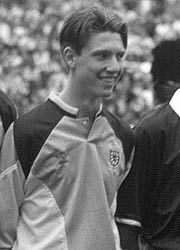
Name: Jim Will
Date and country of birth: 7 October 1972 , Scotland
Jersey numbers: #1, #12
Position: Goalkeeper
Record: Golden Ball winner in the U-17 FIFA World Cup, the only non-outfield player
He is the only goalkeeper to win the best player’s award in a youth World Cup and was thought as one of the best goalies in the world when he was a teen. However, he was not meant to be the “next Lev Yashin”.
Jim Will began playing soccer in Turriff, Scotland, his tiny hometown of a 5,000 population. He registered with the local club United in the mid-1980s, joining its youth squad. Will immediately impressed in goal and even gained first-team experience with United in the 7th tier of Scottish soccer. Arsenal’s scouts spotted him and he subsequently moved to London joining the Gunners’ academy in 1988. The dream for the Scottish shot-stopper was there, fully alive. And the possibilities of geting a call to George Graham‘s first team one day were increasing with his weekly performances.
The previous season, in May 1988, Arsenal U-18 had won its first FA Youth Cup since 1971 and the third in its history, beating easily Doncaster Rovers in the final. The winning squad was captained by midfielder David Hillier, while Kevin Campbell was leading the attack and Alan Miller was the goalkeeper. There was also a Scottish player, 17 year-old left-back Jim Carstairs who helped Will settle in. And in his first season not only he emerged as the U-18’s regular goalkeeper pipping out Alan Miller, but he received a call-up from Scotland U-17 manager Craig Brown. He would represent his national team in the 1989 FIFA U-17 World Championship, hosted by Scotland. He was Scotland’s first choice goalkeeper in a powerful squad that also included his Arsenal teammate Paul Dickov, Brian O’Neil and midfielder Andy McLaren. And he woud show his credentials conceding just three goals.
The Scots advanced to the knock-out stage after finishing runners-up in their group leaving out Nii Lamptey‘s Ghana. On June 17, 1989, Scotland beat East Germany in the quartefinals with Will keeping a clean sheet. Same story three days later against Portugal in the semifinals: the Portuguese coached by Carlos Queiroz were the hot favourites to win the tournament with players like Luis Figo, Emilio Peixe and Abel Xavier. But Jim Will saved his team on numerous occasion during the match.
Despite the fact that Scotland were unlucky in the Hampden Park final against Saudi Arabia losing 5-4 on penalties after 120 goalless minutes, Will won the Golden Ball trophy, leaving future Ballon d’Or winner Luis Figo in the second place. A significant award that players like Landon Donovan, Toni Kroos, Nii Lamptey, Anderson, Cesc Fábregas, Sinama Pongolle and Phil Foden also won in the following editions. Other young stars who participated in the 1989 tournament were 16 year-old Claudio Reyna, Argentinian defender Luis Medero, Nigerian striker Victor Ikpeba and Colombian forward Henry Zambrano. As about the goalkeepers he outshone? Australia’s Mark Schwarzer, Argentina’s Roberto Abbondanzieri, and Saudi Arabia’s eventual gold medal winner Mohamed Al-Deayea.
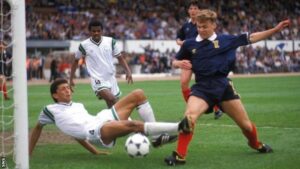
The next two seasons saw Will still in the youth squad until 1991 when he was promoted to the first team by Arsenal’s Scottish manager George Graham. However there was no space for 19-year-old Jim Will in the squad of the 1991 English champions, with goalkeeper David Seaman playing in every game of the season. Dislodging the 1990s England goalkeeper was not an easy task. After 3 seasons, Will left the Highbury Park without a first-team game.
In 1994 he returned to Scotland, signing for Dunfermline Athletic, an ambitious team managed by Bert Paton and with Jackie McNamara in their defence were aiming at promotion to the Socttish Premier League. Will would not play a big part in that project. He registered just 6 appearances in his first season. There would be no second. He was released by the club and quit soccer at the age of 23. Those 6 appearances in Scotland’s second tier were his his only professional games.
He later returned to his village playing again for Turriff United, in the sixth Scottish division. He also played for amateur club Deveronvale, before joining United for a third time. Disillusioned with soccer, he gave up on his dream to pursue a pro career. However he made a surprise comeback in 2007, at 35, signing for fourth division Peterhead where he played two games.


